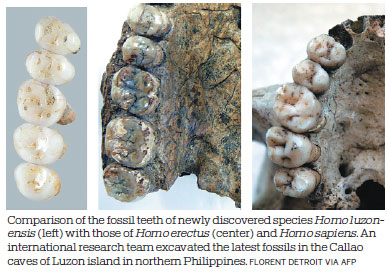New human species shakes up family tree




Discovery in Philippines spurs researchers to dig deeper into evolution, migration
The discovery of a new species and possible human ancestor is raising questions about existing theories of evolution and the human tree, according to latest research.
An international research team found seven teeth and six bones they say belonged to two adults and one child of a new ancient species in the limestone Callao caves on Luzon island in northern Philippines.
The newly discovered Homo luzonensis species has been named after Luzon, the country's largest and most populous island, where the fossils were discovered in 2007, 2011 and 2015. According to a new paper published in the Nature science journal last week, the Homo luzonensis bones are estimated to be about 67,000 years old.
"It's probably the biggest discovery in a while and adds new elements to theories of human dispersal," said Patrick Roberts, group leader of the Stable Isotope Laboratory in the department of archaeology at the Max Planck Institute for the Science of Human History in Germany.
"This finding is significant because it provides more evidence for the complexity of human evolution in East Asia," said Shara E. Bailey, an associate professor of anthropology at New York University.
"It is particularly exciting because nearly every new species announced in the past 15 years has indicated that either there were many more species than just H. sapiens during the Late Pleistocene, or that we have been underestimating just how morphologically variable currently accepted species are."
Homo luzonensis was likely small at between three and four feet, as indicated by the size of its small jaw with little teeth. Since the size of teeth is thought to be indicative of body size, it is possible that Homo luzonensis might even be smaller than Homo floresiensis, a dwarfed species, which is also from Asia. The two, however, are not necessarily related.
Homo luzonensis is thought to have walked upright and use stone tools. It had feet shaped in a way that made climbing easier and a distinct anatomy, even different from modern humans. Roberts noted that features like the curved finger and toe bones hint that climbing may have been an important aspect of Homo luzonensis' survival on a tropical island, which gives insight to both the environment of the time and adds to the possibility that this is its own species.
"The family tree is now more complicated. So they are hominids that were able to successfully reach the island, adapt and change their physicality," said Armand Salvador Mijares, a Filipino archaeologist who led the expeditions that discovered Homo luzonensis, in a news conference to announce the findings.
Mijares was also adamant that Homo luzonensis was not our ancestors, based on their three rooted molars. He also believes that it originally came from Africa.
The possibility of Homo luzonensis being an environmentally determined ancestor of Homo erectus, or that its genetics still exist in our gene pool, cannot be ruled out.
The genetic makeup of modern humans is quite diverse and the family tree is increasingly messy. "The lines connecting the dots for our dispersals within and beyond Africa and our evolutionary journey are incredibly patchy," Roberts said.
"The discovery of Homo luzonensis brings up more questions than answers," he conceded. Roberts likened the discovery to a new dot, rather than a definitive line drawn, in the whole picture.
More discoveries in the region, particularly in East, Central and Southeast Asia, could hold the clues to piecing together more of the human puzzle, he said.

(China Daily 04/15/2019 page3)














